What is it?
The Peugeot 308 is the much-anticipated, all-new family hatchback which has been causing something of a stir round these parts, netting no fewer than four stars in our full and comprehensive road test.
That accolade was awarded to the 1.6 e-HDi diesel-powered version. What we have here is the petrol-powered 1.6 THP variant, whose 154bhp makes it the most powerful 308 currently available.
Most powerful, but not the torquiest, mind. The 1.6 THP’s 177lb fit is shaded not only by the 2.0 e-HDi’s 273lb fit, but also the 1.6 e-HDi’s 199lb ft. But no matter, as the THP engine has some endearing qualities all of its own.
What's it like?
To recap, the new 308 is stylish, impressively well executed and not a little entertaining to drive.
It’s also willfully different inside, where you’ll find a reduced diameter steering wheel and a de-cluttered dash with centralised touchscreen controls for almost everything – features so consciously distracting that they can at first get in the way of making otherwise objective judgements.
Peugeot’s already familiar 1.6 THP engine adds a hushed, smooth zestiness to the mix that is neatly in keeping with the 308’s aspirationally upmarket demeanour. The engine isn’t quite as engagingly free-revving as Ford’s 1.6T EcoBoost unit, but it’s not far off.
In this 154bhp form (there’s also a 123bhp variant of the same engine) it’s whisper quiet at tickover or a cruise, usefully thrusting around town and has enough in reserve for a hint of real entertainment on A and B-roads.
The engine is a good match for the 308’s dynamic package, whose only real bugbear is that reduced-diameter steering wheel. Some drivers may adapt straight away, but for others the extra leverage required at the helm to apply steering inputs, allied to inconsistent power steering weighting, can make it hard to place and turn the car with consistent accuracy. The familiarity of daily use would offset this, but on a short test drive it could make or break the deal.
The 1.6 THP comes at a price, of course, bringing with it higher running costs than the 1.6 diesel (offset in part by a £400 or so cheaper like-for-like asking price).
Peugeot claims 134g/km of CO2 emissions and combined economy of 48.7mpg, but in the real world it’s an act of sustained restraint to better 40mpg where the e-HDi would be rolling along happily around the 50mpg mark.
As we’ve noted before, the as-tested top-level Feline trim comes with 18-inch wheels that do a fine job of transmitting more bump-thump into the cabin than you might like. Better to go for the cheaper (by £1600) Allure trim with its 17s.
Should I buy one?
Whether you go for the Peugeot 308 at all is another matter. If petrol is your thing, comparably specced and engined Ford Focus EcoBoost 1.6T will engage the keen driver with more conviction, while a Volkswagen Golf is simply a better-quality product, albeit a more expensive one with like-for-like specification and engines.
But as it stands, the 308 is now a convincing contender in the family hatch fray and shouldn’t be overlooked.


















Join the debate
Add your comment
Pity
Don't get seduced by raw torque figures.
Torque at the driven wheel is what should be commented upon. A lower revving diesel needs higher gearing, thus torque at the driven wheel is reduced. In very simple terms a petrol unit that revs to 8000 rpm will produce the same torque at the driven wheel as a diesel engine that produces twice the torque but only revs to 4000 rpm, assuming they are geared to reach the same speed with each gear ratio, all other thing being equal such as the torque curve profile. I use those figures for simplicity of example, but it only takes primary school maths to do the same calculations for 'real' petrol and diesel engines within a cars engine line up. Oh, and if you're worried about changing down a ratio in order to overtake perhaps you shouldn't be driving in the first place.
Just buy a Giulietta